Carmagnola
RSP 11039
General Information
- Sample Name
- Carm_24_2_CSU
- Accession Date
- November 19, 2017
- Reported Plant Sex
- Female
- Report Type
- StrainSEEK v2 3.2Mb
- DNA Extracted From
- Unknown
The strain rarity visualization shows how distant the strain is from the other cultivars in the Kannapedia database. The y-axis represents genetic distance, getting farther as you go up. The width of the visualization at any position along the y-axis shows how many strains there are in the database at that genetic distance. So, a common strain will have a more bottom-heavy shape, while uncommon and rare cultivars will have a visualization that is generally shifted towards the top.
Chemical Information
Cannabinoid and terpenoid information provided by the grower.
Cannabinoids
No information provided.
Terpenoids
No information provided.
Genetic Information
- Plant Type
- Type III
File Downloads
The bell curve in the heterozygosity visualization shows the distribution of heterozygosity levels for cannabis cultivars in the Kannapedia database. The green line shows where this particular strain fits within the distribution. Heterozygosity is associated with heterosis (aka hybrid vigor) but also leads to the production of more variable offspring. When plants have two genetically different parents, heterozygosity levels will be higher than if it has been inbred or backcrossed repeatedly.
The ratio of reads mapped to Y-contigs to reads mapped to the whole Cannabis genome (Y-ratios) has been demonstrated to be strongly correlated with plant sex typing. This plot shows the distribution of Y-ratios for all samples in our database which were sequenced with the same method (panel or WGS) as this sample and where this sample falls in the distribution.
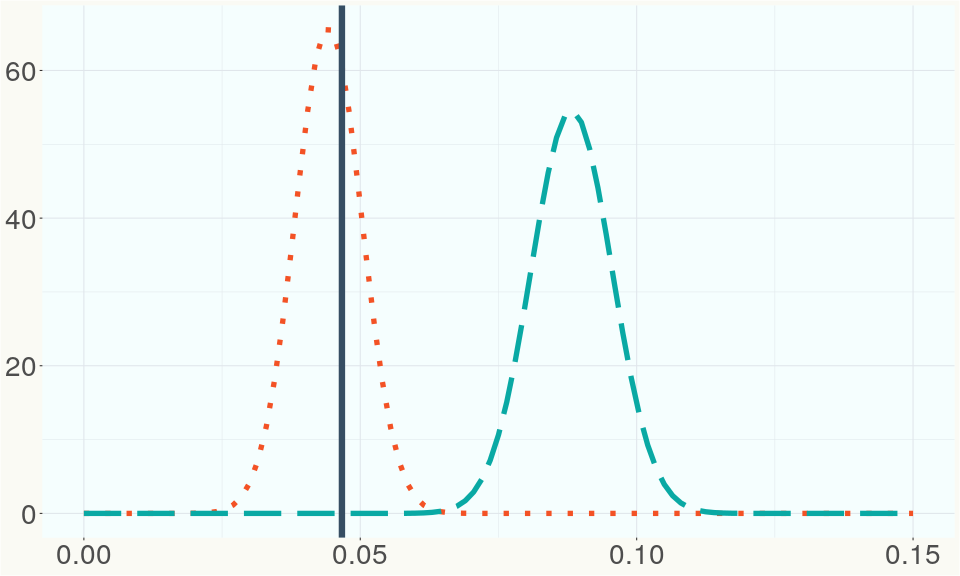
This chart represents the Illumina sequence coverage over the Bt/Bd allele. These are the three regions in the cannabis genome that impact THCA, CBDA, CBGA production. Coverage over the Active CBDAS gene is highly correlated with Type II and Type III plants as described by Etienne de Meijer. Coverage over the THCA gene is highly correlated with Type I and Type II plants but is anti-correlated with Type III plants. Type I plants require coverage over the inactive CBDA loci and no coverage over the Active CBDA gene. Lack of coverage over the Active CBDA and Active THCA allele are presumed to be Type IV plants (CBGA dominant). While deletions of entire THCAS and CBDAS genes are the most common Bt:Bd alleles observed, it is possible to have plants with these genes where functional expression of the enzyme is disrupted by deactivating point mutations (Kojoma et al. 2006).
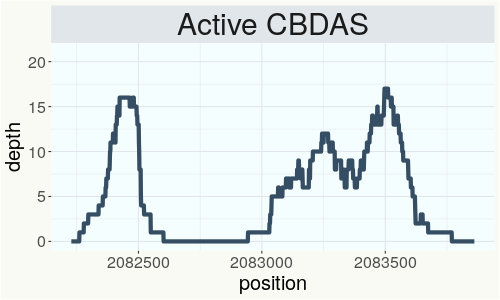
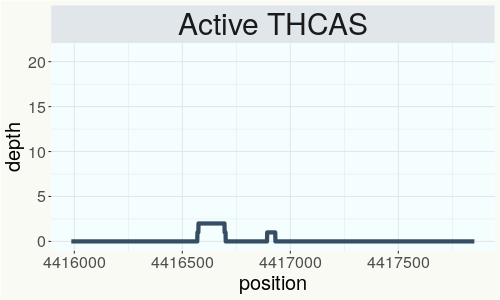
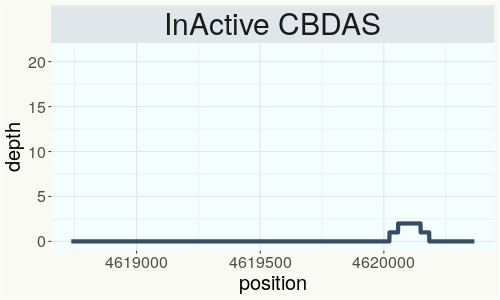
This chart represents the Illumina sequence coverage over the CBCA synthase gene.
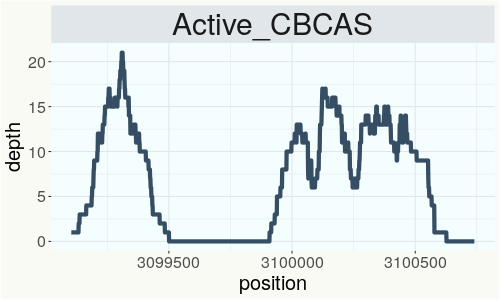
Variants (THCAS, CBDAS, and CBCAS)
No variants to report
Variants (Select Genes of Interest)
| PKSG-2b | c.1117A>G | p.Ile373Val | missense variant | moderate | contig700 | 1950521 | T/C | |
| aPT4 | c.757G>T | p.Val253Leu | missense variant | moderate | contig121 | 2831364 | G/T |
|
| aPT1 | c.574A>T | p.Met192Leu | missense variant | moderate | contig121 | 2840182 | A/T |
|
| aPT1 | c.629C>T | p.Thr210Ile | missense variant | moderate | contig121 | 2840237 | C/T | |
| aPT1 | c.727G>T | p.Glu243* | stop gained | high | contig121 | 2841362 | G/T | |
| HDS-2 |
c.82_93delGT |
p.Val28_Thr3 |
conservative inframe deletion | moderate | contig95 | 1989748 |
CGTAACCGGAAC |
|
| HDS-2 | c.127T>G | p.Ser43Ala | missense variant | moderate | contig95 | 1989794 | T/G |
|
Nearest genetic relatives (All Samples)
- 0.003 Carmagnola (RSP10980)
- 0.004 Carmagnola (RSP11037)
- 0.005 Carmagnola (RSP10977)
- 0.006 Carmagnola (RSP10982)
- 0.134 Carmagnola (RSP10655)
- 0.142 Carmagnola (RSP10976)
- 0.145 Carmagnola (RSP10978)
- 0.145 Carmagnola (RSP10979)
- 0.155 Carmagnola (RSP11202)
- 0.191 CS (RSP11208)
- 0.207 Tisza (RSP11044)
- 0.210 VIR 37 - Novgorod-Seversky - cv (SRR14708234)
- 0.213 Carmagnola USO 31 (RSP11204)
- 0.213 Santhica27 (RSP10056)
- 0.218 Kompolti (SRR14708277)
- 0.221 Santhica 27 (RSP10665)
- 0.222 VIR 483 (SRR14708238)
- 0.222 Lovrin (RSP10658)
- 0.223 Tisza (RSP11045)
- 0.223 Ivory (RSP10668)
Most genetically distant strains (All Samples)
- 0.425 Cherry Blossom (RSP11312)
- 0.425 Chem 91 (RSP11185)
- 0.422 Cherry Blossom (RSP11328)
- 0.418 Cherry Blossom (RSP11298)
- 0.417 Cherry Blossom (RSP11334)
- 0.417 Cherry Blossom (RSP11300)
- 0.412 Queen Dream CBG (RSP11293)
- 0.411 Cherry Blossom (RSP11311)
- 0.410 Escape Velocity (RSP11165)
- 0.409 BagSeed (RSP12627)
- 0.408 Cherry Blossom (RSP11323)
- 0.404 Glueberry OG (RSP11222)
- 0.404 Cherry Blossom (RSP11318)
- 0.403 Super Sour Diesel (RSP11191)
- 0.402 JL Tent 4 (RSP11491)
- 0.402 Cherry Blossom (RSP11301)
- 0.402 Skunk#18 (RSP11038)
- 0.402 RKM-2018-002 (RSP11093)
- 0.402 Cherry Blossom (RSP11309)
- 0.401 New York City Deisel (RSP11225)
Nearest genetic relative in Phylos dataset
- Overlapping SNPs:
- 42
- Concordance:
- 30
Nearest genetic relative in Lynch dataset
- Overlapping SNPs:
- 2
- Concordance:
- 2
Blockchain Registration Information
- Transaction ID
-
0e5a4cafb49fd5c8
c222a7f021f897f3 f64816309f8c21d5 36c78208d6806565 - Stamping Certificate
- Download PDF (865.8 KB)
- SHASUM Hash
-
d252dea9d5075793e490595a13b92ed6 3d342803b3ab3f84 bebef8ebafb03396